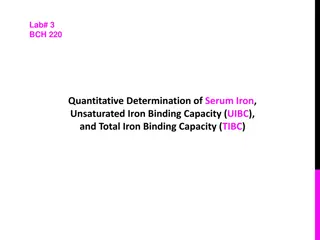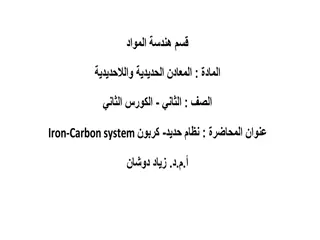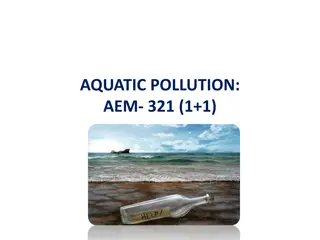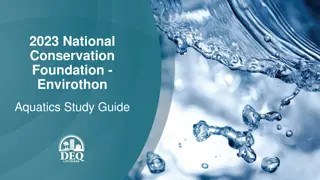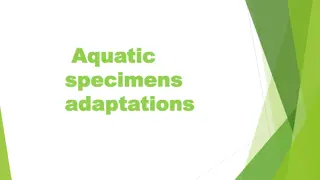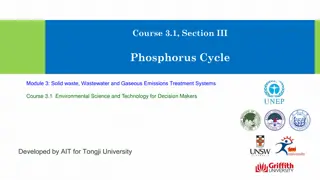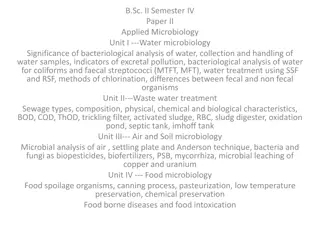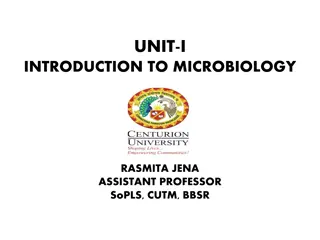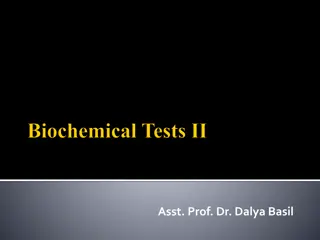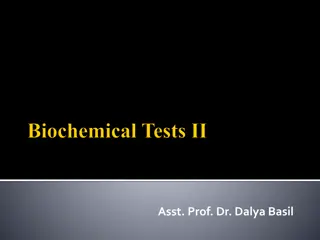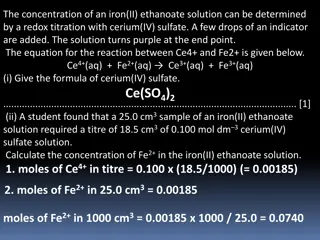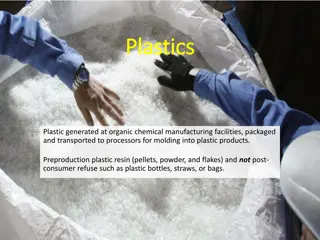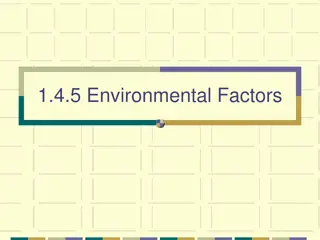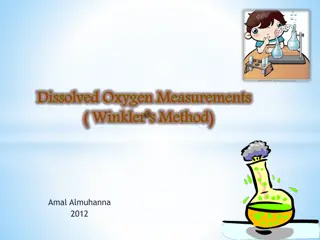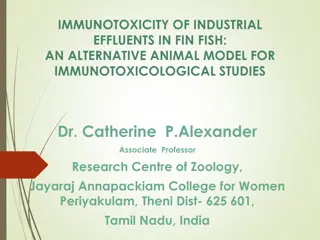The Iron Cycle and Aquatic Microbiology
Iron plays a crucial role in terrestrial and marine ecosystems, cycling between living organisms and the geosphere. It is a vital nutrient for plants, essential for chlorophyll production, and for animals, needed to create hemoglobin. The marine iron cycle involves phytoplankton and cyanobacteria assimilating iron, with potential implications for climate change. Aquatic microbiology focuses on microscopic organisms in water systems, particularly bacteria, viruses, and fungi.
Download Presentation

Please find below an Image/Link to download the presentation.
The content on the website is provided AS IS for your information and personal use only. It may not be sold, licensed, or shared on other websites without obtaining consent from the author. Download presentation by click this link. If you encounter any issues during the download, it is possible that the publisher has removed the file from their server.
E N D
Presentation Transcript
The Iron Cycle Iron is an important limiting nutrient required for plants and animals; it cycles between living organisms and the geosphere. *Iron is an important limiting nutrient for plants, which use it to produce chlorophyll. Photosynthesis depends on adequate iron supply. Plants assimilate iron from the soil into their roots. *Animals consume plants and use the iron to produce hemoglobin, the oxygen transports protein found in red blood cells. When animals die, decomposing bacteria return iron to the soil. *The marine iron cycle is very similar to the terrestrial iron cycle, except that phytoplankton and cyanobacteria assimilate iron.
Iron (Fe) follows a geochemical cycle like many other nutrients. Iron is typically released into the soil or into the ocean through the weathering of rocks or through volcanic eruptions. The Terrestrial Iron Cycle: In terrestrial ecosystems, plants first absorb iron through their roots from the soil. Iron is required to produce chlorophyll, and plants require sufficient iron to perform photosynthesis. Animals acquire iron when they consume plants, and iron is utilized by vertebrates in hemoglobin, the oxygen-binding protein found in red blood cells. Animals lacking in iron often become anemic and cannot transmit adequate oxygen. Bacteria then release iron back into the soil when they decompose animal tissue.
The Marine Iron Cycle: The oceanic iron cycle is similar to the terrestrial iron cycle, except that the primary producers that absorb iron are typically phytoplankton or cyanobacteria. Iron is then assimilated by consumers when they eat the bacteria or plankton. In the past three decades there has been research into using iron fertilization to promote algal growth in the world's oceans. Scientists hoped that by adding iron to ocean ecosystems, plants might grow and sequester atmospheric CO2. Iron fertilization was thought to be a possible method for removing the excess CO2 responsible for climate change. Thus far, the results of iron fertilization experiments have been mixed, and there is concern among scientists about the possible consequences of tampering nutrient cycles.
Aquatic microbiology Aquatic microbiology is the science that deals with microscopic living organisms in fresh or salt water systems. While aquatic microbiology can encompass all microorganisms, including microscopic plants and animals, it more commonly refers to the study of bacteria, viruses, and fungi and their relation to other organisms in the aquatic environment. Bacteria, viruses, and fungi are widely distributed throughout aquatic environments. They can be found in fresh water rivers, lakes, and streams, in the surface waters and sediments of the world's oceans, and even in hot springs. They have even been found supporting diverse communities at hydrothermal vents in the depths of the oceans.
Microorganisms living in these diverse environments must deal with a wide range of physical conditions, and each has specific adaptations to live in the particular place it calls home. For example, some have adapted to live in fresh waters with very low salinity, while others live in the saltiest parts of the ocean. Some must deal with the harsh cold of arctic waters, while those in hot springs are subjected to intense heat. In addition, aquatic microorganisms can be found living in environments where there are extremes in other physical parameters such as pressure, sunlight, organic substances, dissolved gases, and water clarity.
Aquatic microorganisms obtain nutrition in a variety of ways. For example, some bacteria living near the surface of either fresh or marine waters, where there is often abundant sunlight, are able to produce their own food through the process of photosynthesis. Bacteria living at hydrothermal vents on the ocean floor where there is no sunlight can produce their own food through a process known as chemosynthesis, which depends on preformed organic carbon as an energy source. Many other microorganisms are not able to produce their own food. Rather, they obtain necessary nutrition from the breakdown of organic matter such as dead organisms.
Aquatic microorganisms play a vital role in the cycling of nutrients within their environment, and thus are a crucial part of the food chain. Many microorganisms obtain their nutrition by breaking down organic matter in dead plants and animals. As a result of this process of decay, nutrients are released in a form usable by plants. These aquatic microorganisms are especially important in the cycling of the nutrient s nitrogen, phosphorus, and carbon. Without this recycling, plants would have few, if any, organic nutrients to use for growth. In addition to breaking down organic matter and recycling it into a form of nutrients those plants can use, many of the microorganisms become food themselves? There are many types of animals that graze on bacteria and fungi.
For example, some deposit-feeding marine worms ingest sediments and digest numerous bacteria and fungi found there, later expelling the indigestible sediments. At sewage treatment plants, microscopic bacteria are cultured and then used to break down human wastes. However, in addition to the beneficial uses of some aquatic microorganisms, others may cause problems for people because they are pathogens, which can cause serious diseases. For example, bacteria such as Salmonella typhi, S. paratyphi, and the Norwalk virus are found in water contaminated by sewage can cause illness. Fecal coli form (E. coli) bacteria and Enterococcus bacteria are two types of microorganisms that are used to indicate the presence of disease-causing microorganisms in aquatic environments.
Ecology of a Stratified Lake The role of microbes in the global cycle of elements can be visited on a smaller scale, in a lake, for example, like Lake Mendota, which may become stratified as illustrated in Figure. The surface of the lake is well-lighted by the sun and is aerobic. The bottom of the lake and its sediments are dark and anaerobic. Generally, there is less O2 and less light as the water column is penetrated from the surface. Assuming that the nutrient supply is stable and there is no mixing between layers of lake water, we should, for the time being, have a stable ecosystem with recycling of essential elements among the living systems.
Here is how it would work. At the surface, light and O2 are plentiful, CO2 is fixed and O2 is produced. Photosynthetic plants, algae and cyanobacteria produce O2, cyanobacteria can even fix N2; aerobic bacteria, insects, animals and plants live here. At the bottom of the lake and in the sediments, conditions are dark and anaerobic. Fermentative bacteria produce fatty acids, H2 and CO2, which are used by methanogens to produce CH4. Anaerobic respiring bacteria use NO3 and SO4 as electron acceptors, producing NH3 and H2S. Several soluble gases are in the water: H2, CO2, CH4, NH3 and H2S.
The biological activity at the surface of the lake and at the bottom of the lake may have a lot to do with what will be going on in the middle of the water column, especially near the interface of the aerobic and anaerobic zones. This area, called the thermocline, is biologically very active. Bacterial photosynthesis, which is anaerobic, occurs here, using longer wave lengths of light that will penetrate the water column and are not absorbed by all the plant chlorophyll above. The methanotrophs will stay just within the aerobic area taking up the CH4 from the sediments as a carbon source, and returning it as CO2. Lithotrophic nitrogen and sulfur utilizing bacteria do something analogous: they are aerobes that use NH3 and H2S from the sediments, returning them to NO3 and SO4.



